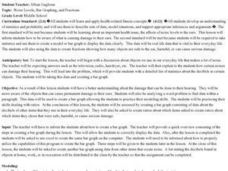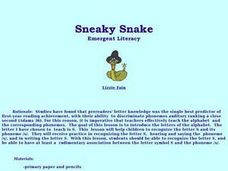Curated OER
Tim the Turtle Takes Two Turns Today
First graders examine the way their mouths move when making the /t/ sound at the beginning and middle of a word. Next, they recite a tongue twister and write the letter. They listen to "A Cat Nap," discuss the story, and write a message...
Curated OER
Ehhh?? I Can't Hear You!
Students identify the /e/ sound in spoken words in this lesson plan. They say a tongue twister with words emphasizing the short /e/ sound. They then listen to the story "Peg the Hen" and do an "I Can't Hear You" motion whenever they...
Curated OER
"Whaaa" Said The Baby"
Young scholars recognize phonemes that correspond with the letters in the alphabet. They focus on identifying the short a, /a/ sound. They examine the way their mouths move when making the short a sound mimicking a baby's cry. In given...
Curated OER
I Am A Musician- Musician as Listener
Students listen for sounds as they complete another activity. Hearing a triangle, they raise their hand once they hear it. They discover that to be part of an ensemble they must listen to themselves and others around them. They discuss...
Curated OER
E.T. Phone Home
Students participate in a game designed to help them focus on listening skills. They divide into team and choose one member to go into the middle of the field. They in the middle of the field are blindfolded, spun and 'called' back home.
Curated OER
Move Over, Beethoven
Second graders create an ABA introductory composition using various, student-chosen sound sources. They create their composition in small groups and perform them for the class.
Curated OER
The Respiratory System
Students explore the parts of the respiratory system in this six lessons unit. The lessons presnt the concepts of the breathing, the function of oxygen in the system, how sounds are made, and the effects of pollution, smoking and disease...
Curated OER
And The Oscar Goes To?
Third graders complete a graphic organizer to determine what a good story looks and sounds like. Using various forms and conventions, they determine which style to use for different audiences and purposes. They write their own story and...
Curated OER
Who Participates? Identifying Diversity
Young scholars listen to sound bite of producer/director Nick Giannopoulos, and discuss issue of stereotypical portrayals of cultural groups presented in the media. Students then use questionnaires and view popular television shows to...
Curated OER
Copycat, Copycat!
Students observe that sometimes the letter "c" is a copycat letter and sometimes acts like a "k" or an "s" like in the words "cat" and "race". They use Elkonin letter boxes and letters to spell words as they are called out by the...
Curated OER
Noise Levels, Bar Graphing, and Fractions
Young scholars research items that can damage hearing. They explore statistics about the decibels of certain objects. From the information collected, students create a bar graph. They formulate ratios to determine what sounds are...
Curated OER
From Magpies to Messiaen: Birds in Music
Middle schoolers in a music class discuss the influence birds have had on music throughout history. In groups, they create their own music using bird sounds and discuss how many composers must use everyday materials to help with their...
Curated OER
Technology: Rating Inventions
Third graders brainstorm a list of inventions used daily. They use Kidspiration to create a web with inventions in the middle. Students choose three inventions from the web and rank them according to interest.
Curated OER
Convection Currents
Students explain and understand the circulation of air in the atmosphere. They identify that energy can be carried from one place to another by heat flow or by waves, including water, light and sound waves, or by moving objects. ...
Curated OER
Musical Concept
Fourth graders practice musical forms to be able to recognize similar and different sections to a song. They review that music has a beginning, middle and an end and discover this process through the "Viennese Musical Clock" that...
Curated OER
Around Your School - Bonding Students to Staff
Learners participate in an interview of a school employee. In this interview instructional activity, students develop appropriate interview questions and carry out an interview of a school employee to show that all jobs well done is...
Curated OER
AAAAAAAAAAA! Stop Crying!
Learners practice recognizing the phoneme /a/ in spoken words. They interact with the book, "A Cat's Nap," and a poster with Abby and Allen on it that are asking animals for apples, and cards with words on them like at, mad, went, bag,...
Curated OER
Sneaky Snake Emergent Literacy
Students are introduced to letters of the alphabet, specifically the letter S. Students recognize the letter S and its phoneme /s/ and receive practice in recognizing the letter S, hearing and saying the phoneme /s/, and in writing the...
Curated OER
CVC Words: Medial Vowel E
In this medial vowel e worksheet, students color in all objects in a set of pictures that have the sound "e" in them; students are to be reminded of the middle e sound before beginning.
Curated OER
Initial R Blends
In this initial r blend worksheet, students look at pictures and write the correct sound for the beginning blend, middle vowel and final sound of each picture.
Curated OER
CVC Words-Beginning Sound
In this CVC beginning sound worksheet, students say picture words, guess which letter makes the beginning sound, circle the letters that make the middle and final sound and then spell the word beneath each picture.
Curated OER
Initial R Blends
In this initial blend worksheet, students say picture words slowly, listening for the initial, middle vowel and ending sounds, then write the word that names each picture.
Curated OER
Ehhh! Can you repeat that!
Students assess how to recognize phonemes that stand for letters creating spoken words utilizing the short vowel /e/. They associate our written language as a secret code to solve. The tongue twister "Everybody saw Eddie and the Eskimo...
Curated OER
Homophones
In this homophones learning exercise, learners read sentences and underline the incorrect word in the sentence while they provide the sentence with the correct homophone. Students complete 15 sentences.

























